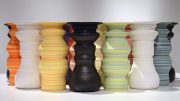Think about your favourite contemporary artist. Do you have one? What do you like about their work?
Now think about your favourite artist ever. Do you have one? What do you like about their work? Is what you like about the former the same as what you like about the latter? It probably isn’t. In fact, if you’re like a lot of people, you probably don’t even have a favourite contemporary artist — especially if Andy Warhol doesn’t count.
Maybe you’ve noted this apparent deficiency in your tastes and tried to remedy it by browsing a contemporary art publication. I have, and was thoroughly repulsed by the insipid, fawning and jargon-filled frenzy of mutual masturbation that now passes for fine art criticism, as you likely have. This repulsion is only sometimes related to the artist’s work itself. More often, the critic’s eagerness to be associated with the artist drives me away.
It wasn’t always this way. John Ruskin, a 19th-century English critic, once famously wrote of James Abbott McNeill Whistler, “I have seen, and heard, much of Cockney impudence before now; but never expected a coxcomb to ask two hundred guineas for flinging a pot of paint in the public’s face.”
John Ruskin was admittedly a peculiar man and evidently a terrible snob (because he derided Whistler for his “Cockney impudence,” not because he criticized his work), but the fact that criticism of this kind was ever so prominent makes me yearn for those good old days.
Time was, artists strove for beauty. Certainly, there was much dispute over what constituted beauty — there were different routes, but everyone was headed for the same finish line. No longer. Today artists “explore” themes and symbols and beauty is a faux pas.
It’s no longer fashionable to have a message or a goal for artwork. Every artist does her own thing, and critics relate their endeavors in as vague and opaque a manner as possible, terrified of being accused of not “getting it.”
Readers and viewers are left frustrated with art that they may have enjoyed, but dismiss as cerebral and senseless as the critic’s description. It’s a highly lamentable state of affairs.
I’ve met a fair few artists this year as Arts Reporter, and the majority aren’t interested in being intellectually intimidating. Certainly some are attracted by the intellectual glamour of the art world, but others just want to make things. The same is true in my experience of internationally known artists. I find delight to no end in art star Damien Hirst’s confession about his “spin-paintings”: “They’re bright and they’re zany — but there’s fuck all there at the end of the day,” he once said of them.
There always have been and always will be good and bad artists. What we need today are good critics to tell us which are which. We may not always agree with them, but perhaps we’ll find one we like and stick to her.
To be fair, there are some critics writing today who aren’t afraid to call a turd a turd, but too often they’re fusty old posh men writing for conservative newspapers. Whatever they have to contribute to the discussion is too easy to dismiss as the sentimental longings of men whose time has past. Furthermore, these critics often dismiss contemporary art categorically, which doesn’t help those of us who believe there must be some value in modern creations.
The world needs fine art critics who know criticism as much as they know fine art, critics who will pan one work, praise another and explain why in a way intelligent outsiders can understand.
I am far from qualified to be such a person, but I have tried over the past eight months to cover the arts, including fine art, without resorting to sweeping, ambiguous claims and insider jargon. I can’t say I always succeeded, but I hope I have convinced someone that the world of fine art doesn’t have to be a confusing miasma of bullshit and that a lot of artists are just as baffled by that miasma as we are.


